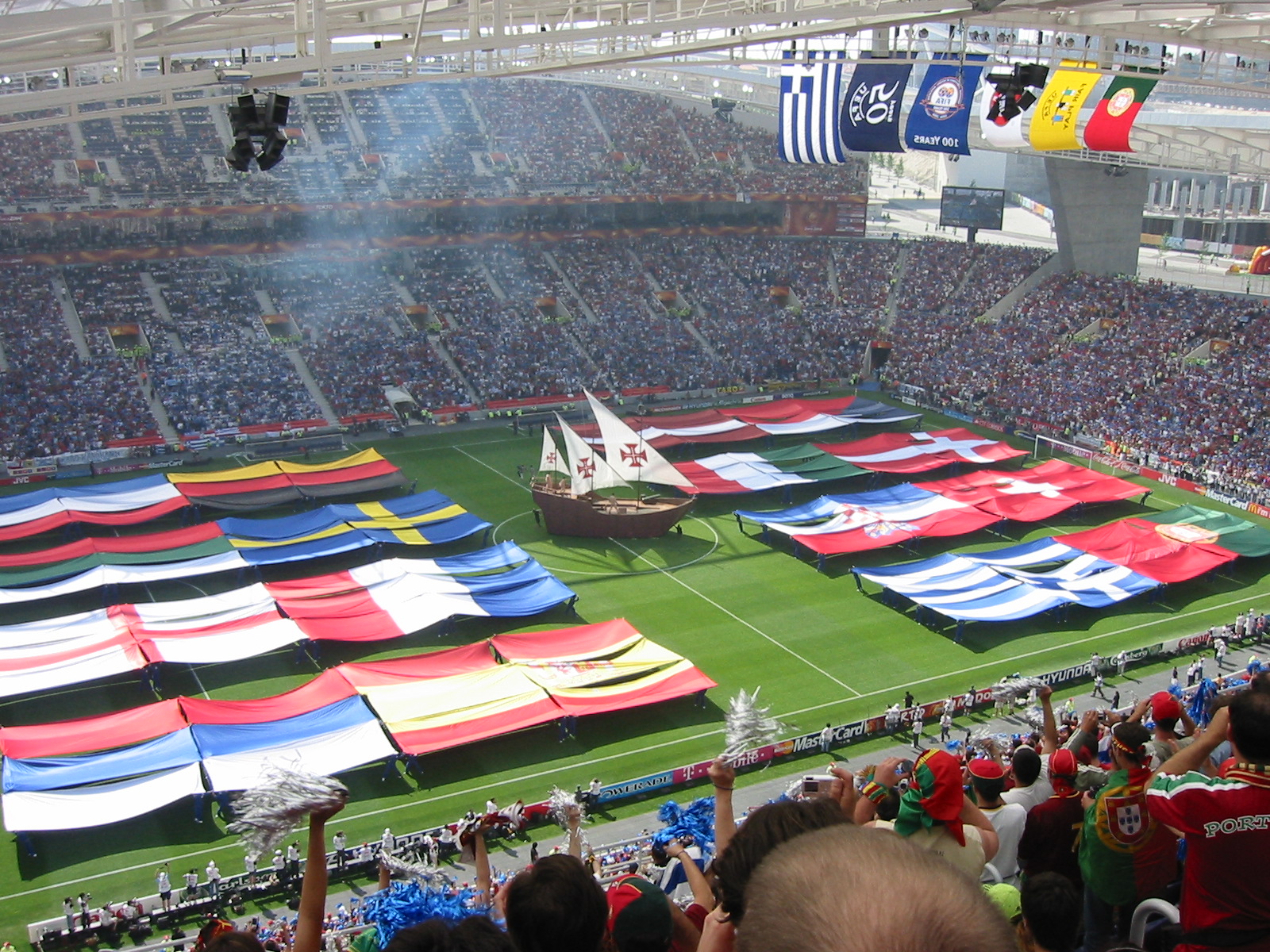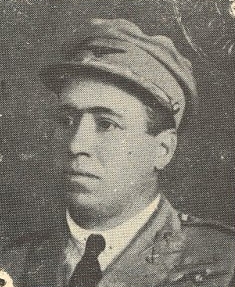|
Estádio Da Luz (1954)
Estádio da Luz (, Stadium of Light), officially named Estádio do Sport Lisboa e Benfica, was a multi-purpose stadium located in Lisbon, Portugal. It was used mostly for football matches and hosted the home matches of S.L. Benfica and the Portugal national team. The stadium was opened on 1 December 1954 and it was able to hold an official maximum of 120,000 people, making it the largest stadium in Europe and the third largest in the world in terms of capacity. Some of the biggest attendances include a game against FC Porto with an estimated attendance between 135,000 and 140,000 people, the 1989–90 European Cup semi-final against Olympique de Marseille and the 1991 FIFA World Youth Championship final between Portugal and Brazil with 127,000 people in each game. It also hosted the 1992 European Cup Winners' Cup Final, the second leg of the 1983 UEFA Cup Final, and the 1962 Intercontinental Cup. Its demolition started in 2002 so the new Estádio da Luz could be built ne ... [...More Info...] [...Related Items...] OR: [Wikipedia] [Google] [Baidu] |
Lisbon
Lisbon (; pt, Lisboa ) is the capital and largest city of Portugal, with an estimated population of 544,851 within its administrative limits in an area of 100.05 km2. Lisbon's urban area extends beyond the city's administrative limits with a population of around 2.7 million people, being the 11th-most populous urban area in the European Union.Demographia: World Urban Areas - demographia.com, 06.2021 About 3 million people live in the Lisbon metropolitan area, making it the third largest metropolitan area in the , after |
Terras Do Desembargador
Terras do Desembargador, also known as Campo das Salésias, was a football dirt field in Lisbon, Portugal. It hosted football matches of Sport Lisboa. In 1903, football was a growing sport, and Terras do Desembargador was Lisbon's main field for playing football. It had no fences and bystanders can freely enter the field and disrupt match. When a ball was lost to outside the field it was difficult to recover it because of the open spaces. Inconveniently it was also shared with the Portuguese Army who used it as an exercise field, so it would often be completely destroyed after a set of exercises. It was in this field that a group a friends after a match decided to create Sport Lisboa. 6 friendlies were played, Sport Lisboa won 5, lost 1, scored 13 goals and conceded 2. Benfica left in 1907 for Campo da Feiteira Campo da Feiteira was a football dirt field Field may refer to: Expanses of open ground * Field (agriculture), an area of land used for agricultural purposes * Air ... [...More Info...] [...Related Items...] OR: [Wikipedia] [Google] [Baidu] |
Tomás Taveira
Tomás Taveira (born 1938) is a Portuguese architect. He has a degree in architecture from the Technical University of Lisbon and owns a post-graduation from the Massachusetts Institute of Technology. Some of his most recognizable works include the Amoreiras Towers in Lisbon, three of the new stadiums for the 2004 UEFA European Football Championship in Portugal and the Allianz Parque stadium in São Paulo, Brazil. Works Tomás Taveira's emblematic buildings include: * Alfragide Towers *Zona J Housing Complex *Amoreiras Towers, Lisbon, Portugal *Arco-Íris Building, Lisbon, Portugal *BNU building, Av. 5 de Outubro, Lisbon, Portugal * Aveiro Stadium, Aveiro, Portugal *Alvalade Stadium, Lisbon, Portugal * Leiria Stadium, Leiria, Portugal *New Arena Palestra Itália, São Paulo, Brazil Controversies Video recordings affair In the 1980s he was involved in a celebrity sex tape controversy when some personal home-made recordings he kept in videotapes were fortuitously discovered b ... [...More Info...] [...Related Items...] OR: [Wikipedia] [Google] [Baidu] |
UEFA Euro 2004
The 2004 UEFA European Football Championship, commonly referred to as Euro 2004, was the 12th edition of the UEFA European Championship, a quadrennial football competition contested by the men's national teams of UEFA member associations. The final tournament was hosted for the first time in Portugal, from 12 June to 4 July 2004. A total of 31 matches were played in ten venues across eight cities – Aveiro, Braga, Coimbra, Guimarães, Faro/ Loulé, Leiria, Lisbon, and Porto. As in 1996 and 2000, the final tournament was contested by 16 teams: the hosts plus the 15 teams that came through the qualifying tournament, which began in September 2002. Latvia secured their first participation in a major tournament after overcoming Turkey in the play-offs, while Greece returned to the European Championship after 24 years. The tournament was rich in surprises and upsets: Traditional powerhouses Germany, Spain, and Italy were eliminated in the group stage, while defending ch ... [...More Info...] [...Related Items...] OR: [Wikipedia] [Google] [Baidu] |
Portuguese Football Federation
The Portuguese Football Federation (FPF) ( pt, Federação Portuguesa de Futebol; ) is the governing body of football in Portugal. The federation was formed in 1914 as Portuguese Football Union (UPF) by the three existing regional associations of Lisbon, Portalegre and Porto, before adopting its current name in 1926, and is based in the city of Oeiras. The (FPF) joined FIFA in 1923 and is also a founding member of UEFA. The Portuguese Federation oversees all aspects of the game of football in Portugal, both professional, amateur and administers the competition committee (including the handling of the trophy) of the Campeonato de Portugal, the Taça de Portugal and the Supertaça Cândido de Oliveira. It is also responsible for appointing the management of the Portugal national football team (men's), women's, and youth national football teams. The men and women's Portugal national futsal team and Portugal national beach soccer team are also organized by the federation. ... [...More Info...] [...Related Items...] OR: [Wikipedia] [Google] [Baidu] |
All-seater Stadium
An all-seater stadium is a sports stadium in which every spectator has a seat. This is commonplace in professional association football stadiums in nations such as the United Kingdom, Spain, and the Netherlands. Most association football and American football stadiums in the United States and Canadian Football League stadiums in Canada are all-seaters, as are most baseball and track and field stadiums in those countries. A stadium that is not an all-seater has areas for attendees holding standing-room only tickets to stand and view the proceedings. Such standing areas are known as terraces in Britain. Stands with only terraces used to dominate the football attendance in the UK. For instance, the ''South Bank Stand'' behind the southern goal at Molineux Stadium, home of Wolverhampton Wanderers, had a maximum of 32,000 standing attenders, while the rest of the stadium hosted a little bit less than that; the total maximum attendance was around 59,000. Some European cou ... [...More Info...] [...Related Items...] OR: [Wikipedia] [Google] [Baidu] |
Joaquim Ferreira Bogalho
Joaquim Ferreira Bogalho (11 December 1889 – 1 October 1977), also known as "the man of the stadium" (), was the 20th president of Portuguese sports club S.L. Benfica. Bogalho was born in Alcobaça in 1889. After being awarded the Águia de Ouro (Golden Eagle) by Benfica on 31 July 1938, he was elected president of the club on 15 March 1952, a position he held until 30 March 1957, being reelected four times. He is considered the main responsible for the modernisation and professionalisation of the football team in 1954 with the signing of coach Otto Glória, and the construction of the original Estádio da Luz and the Centro de Estágio (Training Center), also known as Lar do Jogador (Player's Home). During his five-year presidency, Benfica won the Primeira Liga and Taça de Portugal The Taça de Portugal (; "Cup of Portugal") is an annual association football competition and the premier knockout tournament in Portuguese football. For sponsorship reasons, it has been known ... [...More Info...] [...Related Items...] OR: [Wikipedia] [Google] [Baidu] |
Carnide
Carnide () is a '' freguesia'' (civil parish) and district of Lisbon, the capital of Portugal. Located in northern Lisbon, Carnide is north of São Domingos de Benfica and Benfica, east of Lumiar, and directly south of Lisbon's border with Odivelas. The population in 2011 was 19,218,Instituto Nacional de Estatística (INE) Census 2011 results according to the 2013 administrative division of Portugal Landmarks *Colégio Militar
''Colégio Militar'' ( Portuguese for "Military College") is a military secondary school in Lisbon, Portugal. It was founded by Marechal Ant ...
[...More Info...] [...Related Items...] OR: [Wikipedia] [Google] [Baidu] |
Benfica (Lisbon)
Benfica () is a ''freguesia'' (civil parish) and district of Lisbon, the capital of Portugal. Located in northern Lisbon, Benfica is west of São Domingos de Benfica, Carnide, and Campolide, north of Belém, Ajuda, and Alcântara, and directly east of Lisbon's border with Amadora. The population in 2011 was 36,985,Instituto Nacional de Estatística (INE) Census 2011 results according to the 2013 administrative division of Portugal History [...More Info...] [...Related Items...] OR: [Wikipedia] [Google] [Baidu] |
Estádio Das Amoreiras
Estádio das Amoreiras, also known as Campo das Amoreiras, was a multi-use stadium in Lisbon, Portugal. It was used mostly for football matches and hosted the home games of S.L. Benfica Sport Lisboa e Benfica (), commonly known as Benfica, is a professional football club based in Lisbon, Portugal, that competes in the Primeira Liga, the top flight of Portuguese football. Founded on 28 February 1904 as ''Sport Lisboa'', B .... Opened in 1925, the stadium was able to hold 20,000 spectators. It was demolished in 1940 to make way for a freeway. Benfica would then move to Estádio do Campo Grande. External links S.L. Benfica profile Defunct football venues in Portugal S.L. Benfica Sports venues completed in 1925 Sports venues demolished in 1940 {{Portugal-sports-venue-stub ... [...More Info...] [...Related Items...] OR: [Wikipedia] [Google] [Baidu] |
Sporting Clube De Portugal
Sporting Clube de Portugal, founded Sporting Club de Portugal (), otherwise referred to as Sporting CP, often known abroad as Sporting Lisbon , is a Portuguese professional sports club based in Lisbon. It is best known for the professional football team playing in the Primeira Liga, the top flight of Portuguese football. Founded on 1 July 1906, Sporting is one of the " Big Three" clubs in Portugal that have never been relegated from Primeira Liga, along with rivals Benfica and Porto. Sporting are nicknamed ''Leões'' (Lions), for the symbol used in the middle of the club's crest, and ''Verde e Brancos'' (Green and Whites), for the shirt colour that are in (horizontal) stripes. Their home ground has been the Estádio José Alvalade, built in 2003, which replaced the previous one, built in 1956. The club's anthem is called "''A Marcha do Sporting''" ("Sporting's March", written in 1955) and its supporters are called ''Sportinguistas''. Sporting are the second largest sports ... [...More Info...] [...Related Items...] OR: [Wikipedia] [Google] [Baidu] |
Estádio Do Campo Grande
Estádio de Campo Grande was a multi-use stadium in Lisbon, Portugal. It was used mostly for football matches and hosted the home matches of Sporting CP and then S.L. Benfica. The stadium was able to hold 25,000 people and opened in 1912 owned by Lisboa FC. In 1917, Lisboa FC leaves and ground is taken over by Sporting CP which uses it until 1937, leaving for Estádio do Lumiar. In 1941, Benfica moved in after Estádio das Amoreiras was demolished for a freeway. By then, the stadium needed renovations and was abandoned for over 3 years. It was closed in 1954 when the original Estádio da Luz opened. References External linksHistory by Sporting CP (archived) Campo Grande Campo Grande Campo Grande (, ) is the capital and largest city of the Brazilian state of Mato Grosso do Sul in the Center-West region of the country. The city is nicknamed ''Cidade Morena'' ("Swarthy City" in Portuguese) because of the reddish-brown colour o ... Sporting CP Sports venues completed in ... [...More Info...] [...Related Items...] OR: [Wikipedia] [Google] [Baidu] |






